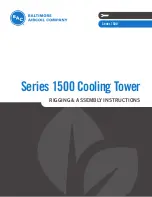
107
Installation
Due to our policy of continuous product innovation, some specifications may change without notification.
©LG Electronics U.S.A., Inc., Englewood Cliffs, NJ. All rights reserved. “LG” is a registered trademark of LG Corp.
Blowers
Table 66: Troubleshooting Blowers Table.
TROUBLESHOOTING
Blower Symptom
Probable Cause
Action
Excessive noise
Impeller hitting inlet ring.
Check that impeller is centered on inlet ring.
Check for damage on inlet ring; replace inlet ring.
Check for crooked or damaged impeller; replace
impeller.
Check if shaft is loose in bearing; replace motor.
Check if impeller is loose on shaft; tighten impeller set
screw.
Defective bearing.
Replace motor
Shaft seal squeals.
Replace motor
Impeller
Check if impeller is loose on shaft; tighten impeller.
Defective impeller:
DO NOT RUN. Contact the
unit manufacturer.
Check if impeller is unbalanced; replace impeller
Check if impeller is worn because abrasive or
corrosive material is moving through flow
passages.
Housing
Check for foreign material in housing.
Check if block-off or other part is loose (rattling during
operation).
Electrical
Confirm that lead-in cable is secure.
Check for AC hum in motor or relay.
Check for starting relay chatter.
Check if 3-phase motor is wired for single phase.
High air velocity
Check if duct work is too small for application.
Check if fan selection is too large for application.
Check if registers or grilles are too small for
application.
Check if heating or cooling coil has insufficient face
area for application.
Obstruction in high-velocity gas stream (rattle or
pure-tone whistles).
Check damper sizing.
Check register sizing.
Check grille sizing.
Check for sharp elbows.
Check for sudden expansion or contraction in
ductwork.
Check turning vanes.
Pulsation or surge.
Check if restricted system causes fan to operate at a
poor point of rating.
Check if fan is too large for application.
Check if ducts vibrate at same frequency as fan
pulsations.
Gas velocity through cracks or holes, or past
obstructions.
Check for leaks in duct work.
Check the fins on coils.













































